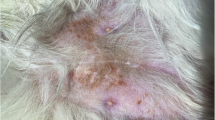Abstract
After very hot summer, 22 sheep from 5 different flocks consisting of approximately 150–200 animals each were diagnosed with facial eczema in September 2005, in southwest Turkey. Photophobia, corneal opacity, severe ulcers of the facial skin, especially localized around the eyes and mouth, and 3% mortality were the most prominent clinical symptoms. GGT levels of the animals were very high and varying between 261- 328 U/l. While the activities of ALT and total bilirubin were elevated and AST was normal in affected sheep. Total bilirubin level was higher than normal. Seven of the 22 sheep were euthanatized and necropsy was performed on all of these animals. Severe icterus, hepatomegaly, enlarged gallbladder, congestion of mesenteric vessels were the common necropsy findings. Histopathological changes of the liver included necrosis of the hepatocytes, cholangiohepatitis characterized by mononuclear inflammatory cell infiltrate in the portal area and mild to severe fibrosis around bile ducts. A diagnosis of sporidesmin toxicosis was made based on the histopathology of the livers, the elevation in liver enzymes, and the development of cutaneous lesions consistent with photosensitization and high spore counts in the ruminal contents. Surviving sheep were treated with procaine penicillin + dihidrostreptomycin sulfate, multivitamin complexes and flunixin meglumine. Additionally, zinc sulphate was also given at a dose of 6 gr per 100 lt drinking water for 28 days. All treated sheep recovered. Pasture spore counts were between 96,300- 267,500 spores/g grass.






Similar content being viewed by others
Abbreviations
- GGT:
-
Gamma Glutamyltransferase
- ALT:
-
Alanine Aminotransferase
- AST:
-
Aspartate aminotransferase
References
Coetzer, J.A., Kellerman, T.S., Sadler, W. and Bath, G.F., 1983. Photosensitivity in South Africa. V. A comparative study of pathology of the ovine hepatogenous photosensitivity diseases, facial eczema and geeldikkop (Tribulosis ovis), with special reference to their pathogenesis. Onderstepoort Journal of Veterinary Research, 50(1), 59–71.
Collin, R.G., Odriozola, E., Towers, R.N., 1998. Sporidesmin production by Pithomyces chartarum isolates from Australia, Brasil, New Zealand and Uruguay. Mycological research, 102, 163–166.
di Menna, M. E., 1977. The wash method of counting Pithomyces chartarum spores in pasture. Proceedings of the Ruakura Farmers’ Conference: 1–8.
Hansen, D.E., McCoy, R.D., Hedstrom, O.R., Snyder, S.P. and Ballerstedt, P.B., 1994. Photosensitization associated with exposure to Pithomyces chartarum in lambs, Journal of the American Veterinary Medical Association, 204 (10), 1668–1671.
Hargis, A.M., 1995. Thomson’s Special Pathology, (Mosby Publishing, Missouri).
Jones, T.C., Hunt, R.D., and King, N.W., 1997. Veterinary Pathology,(Williams and Wilkins, Maryland).
Jubb, K.V.F., Kennedy, P.C., and Palmer, N., 1993. Pathology of Domestic Animals, (Academic Press. Inc., London).
Kellerman, T.S., Van der Westhuizen, G.C., Coetzer, J.A., Raux, C., Marasas, W.F., Minne, J.A., Bath, G.F., and Bsaaon, P.A., 1980. Photosensitivity in South Africa. II The experimental production of the ovine hepatogenous photosensitivity disease geeldikkop (Tribulosis ovis) by the simultaneous ingestion of Tribulus terrestris plants and cultures of Pithomyces chartarum containing the mycotoxin sporidesmin. Onderstepoort Journal of Veterinary Research, 47(4), 231–261.
Morris, C.A., Towers, N.R., Hohenboken, W.D., Maqbool, N., Smith, B.L., and Phua, S.H., 2004. Inheritance of resistance to facial eczema: a review of research findings from sheep and cattle in New ZealandNew Zealand Veterinary Journal, 52(5), 205–215.
Radostits, O.M., Gay, C.C., Blood, C. and Hinchcliff, K.W., 2000. Veterinary Medicine, (W.B. Saunders Company, London).
Smith, B.L. and Embling, P.P., 1991. Facial eczema in goats-The toxicity of sporidesmin in goats and its pathology. New Zealand Veterinary Journal, 39(1), 18–22.
Smith, B.L., Embling, P.P., and Gravett, I.M., 1987. Pithomyces chartatum spores counts in rumen contents and faeces of sheep exposed to autumn pasture at three different grazing pressures. Journal of Applied Toxicology, 7(3), 179–184.
Troutt, C. and Levetin, E., 2001. Correlations and meteorological conditions in Tulsa, Oklahoma.International Journal of Biometeorology, 45(2), 64–74
Author information
Authors and Affiliations
Corresponding author
Rights and permissions
About this article
Cite this article
Ozmen, O., Sahinduran, S., Haligur, M. et al. Clinicopathological studies on facial eczema outbreak in sheep in Southwest Turkey. Trop Anim Health Prod 40, 545–551 (2008). https://doi.org/10.1007/s11250-008-9132-7
Received:
Accepted:
Published:
Issue Date:
DOI: https://doi.org/10.1007/s11250-008-9132-7




